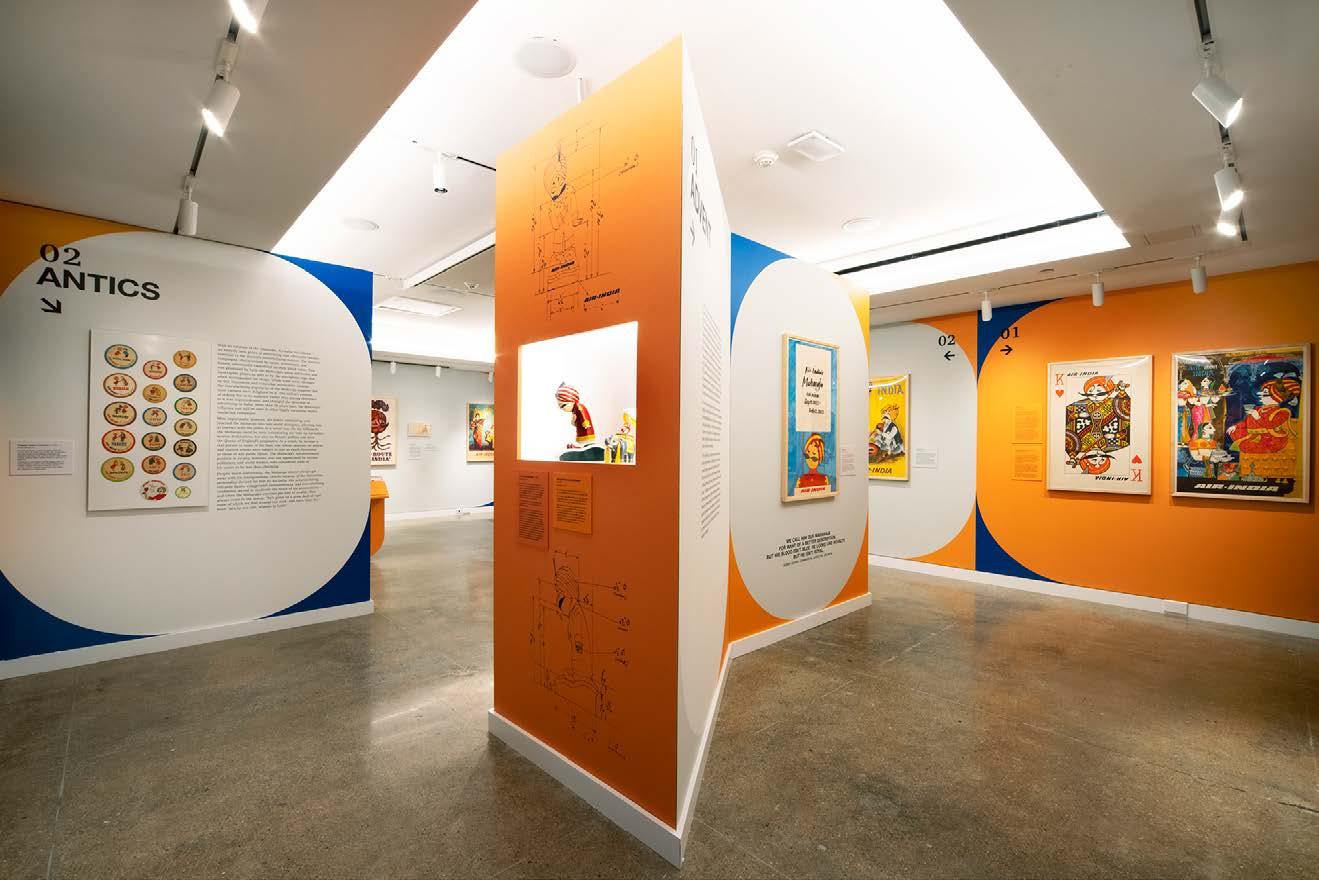Past Exhibition



Sep 9, 2022–Feb 12, 2023
The Rogue’s Gallery, published by Air-India in 1977, was a catalog showcasing the most iconic travel posters produced by the airline between 1946 and 1972. The star of these posters was Air-India’s beloved mascot, the Maharaja, alias “the Rogue.” Conceived in 1946 by Bobby Kooka and illustrated by Umesh Rao, the Maharaja was initially designed for an in-flight memo pad. The corpulent mascot, characterized by his oversized mustache, striped turban, and aquiline nose, would go on to represent the airline and propel the company to the forefront of advertising design.
The Maharaja’s birth coincided with that of a new nation, and, ironically, with the end of princely rule in India. As the former maharajas (rulers of the principal native states of India) were ushered out of their positions in society and politics, the Air-India Maharaja rose to fame, soon becoming a household name. He was the perfect symbol for a rapidly expanding company that sought to stake its claim in international tourism. As one of the world’s least-inhibited travelers, the Maharaja developed a reputation for his daring and panache, adopting different personas in every destination—a snake charmer in India, a monk in Rome, a lover boy in Paris, and even a Playboy Bunny in New York.
The Maharaja, however, experienced his fair share of controversy over the years—Air-India was repeatedly asked by prominent international figures to rescind advertisements they found to be shocking or insulting. Despite the complaints of ill-humored politicians, the Maharaja and his cutting-edge design earned the company numerous advertising awards and a legion of loyal fans. Rendered in styles inspired by sources as diverse as Indian ragamalas (a form of Indian miniature painting) and the Belle Époque posters of Henri de Toulouse-Lautrec, the Maharaja became renowned not just for his mischief, but also for his iconic design. While the Maharaja remains Air-India’s mascot to this day, he is most fondly and widely remembered for his prominent role during India’s golden age of advertising.
This exhibition was created in partnership with Kapoor Galleries in New York City and Indo-American Arts Council.
Unless otherwise noted, all posters are part of the Poster House Permanent Collection.

Curation
Carly Johnson
Sophia Williamson
Sanjay Kapoor
Exhibition Design
Ola Baldych
Installation
John F. Lynch
Special Thanks
Piyush Khaitan, collector
Dharmdev Maurya, collection manager
Meera Dass, historian
Air-India Exhibition Poster
In 1932, the Indian businessman and aviation pioneer J.R.D. Tata founded Tata Airlines, which became a public limited company in 1946 under the name Air-India Ltd. Only a year later, in 1947, India secured its independence from British imperial rule (splitting into the neighbouring nation states of Pakistan and India.) The princely states, once kingdoms ruled by the maharajas, were incorporated into India, a nation now run by a democratically elected government. In 1948, the Indian government acquired a 49 percent share of the airline, making it the official carrier of the country, and the only one with the right to fly internationally. The airline was now renamed Air-India International Ltd., and, in 1953, the government obtained a majority share in the company. As he entered the global stage, the Maharaja became an international traveler and the face not merely of the airline but also of the new country itself.
In its role as India’s first national carrier, Air-India was concerned with projecting a distinctly Indian identity. At the same time, it had to compete with long-established airlines such as PanAm and Air France that had much larger advertising budgets. In an effort to capture the emerging country’s character, as well as hold its own in the rapidly expanding tourism market, Air-India found its emblem in the Maharaja—a uniquely Indian symbol of both luxury and hospitality.
In 1946, Bobby Kooka, the commercial director of the new Air-India, made his initial renderings of the Maharaja in the guise of an Eastern potentate smoking a hookah while riding a flying carpet. With the help of artist Umesh Rao of the J. Walter Thompson advertising agency in Bombay (Mumbai), these sketches ultimately evolved into the now-iconic mascot. The Maharaja, however, was more than just his good looks; somewhere along the way, Air-India’s advertising team developed his bawdy and irreverent personality. Yet, as the Maharaja took the world by storm, his humble birth was never forgotten; as the airline’s publicity department described it, he was “conceived by Bobby Kooka, delivered by Umesh Rao, raised by Jal B. Cowasji [the airline’s art director], adopted by the world.”

We call him our Maharaja for want of a better description. But his blood isn’t blue. He looks like royalty, but he isn’t royal.
—Bobby Kooka, Commercial Director, Air-IndiaDesigner Unknown
Poster House Permanent Collection
• In this poster, the Maharaja appears in his standard form— eyes closed with a self-assured smile, aquiline nose, red-striped turban, and full mustache.
• He holds a blank sign board of the kind used by travel agents to announce special offers, lending his image to the relevant promotion. Here, we have filled the blank space with our exhibition information.
• The Maharaja’s instantly recognizable appearance partly reflects the contents of a design manual that Air-India printed as a guide for the proper use of its mascot and logo. The book contains sketches of the Maharaja in a variety of poses and situations, including one with J.R.D. Tata himself.

Jacob (Dates Unknown)
Poster House Permanent Collection
• The Maharaja appears here in the guise of the King of Hearts from a deck of playing cards. This poster did, in fact, steal many hearts—in 1969 it was awarded a certificate of merit by the Communication Arts Guild in India.
• Ironically, the choice of a maharaja as a mascot came at a time when Indian maharajas were losing their power. After gaining its independence in 1947, India integrated its princely states into a unified democratic government that no longer had room for royalty. Just as the continuing presence of actual princes was being scrutinized in India, so too was the seemingly regressive choice of the Maharaja as Air-India’s mascot. While to many, the Maharaja was an image of pride, reflecting India’s rich history and culture, to others he was a reminder of a repressive past.
• In a 1965 speech, Bobby Kooka remarked that “sourpusses inour land denounced him as a relic of the feudal system, an insignia not in keeping with a Corporation, the owners of which are our Government. We were reminded that when the country has ‘kaput’ the Maharajas, Rajahs, Nawabs, Princes, and Zamindars, why should this undemocratic symbol portray a false image of our country? We prayed that reason would prevail, and it is comforting to know that the little fellow has now passed more than muster.”

• Despite accusations that he presented a false and retrograde image of India, the choice of the Maharaja as Air-India’s mascot accomplished two things: it created a distinctively Indian (albeit dated) characterization of the company, and it associated the airline with a sense of traditional luxury. These themes were underscored by such slogans as “Air-India…Truly Indian” and “Fly like a Maharaja.”
• After Indian rulers had been ousted by the new democratic government, many went into the tourism business, remodeling their crumbling havelis (palaces) into hotels that catered to the European taste for the “exotic.” Thus, many former maharajas essentially became hotel managers, making the title synonymous with both luxury and hospitality— much like Air-India’s Maharaja mascot.
• While the Maharaja is depicted here in a dignified and regal pose as he is waited on by beautiful women, he is effectively a stand-in for the Air-India passengers who might expect to be “treated like a Maharaja.”

V. V. Shetye (Dates Unknown)
Poster House Permanent Collection
• The Maharaja is illustrated here wearing a red swimsuit in the role of lifeguard, his classic turban replaced by a swim cap decorated with a miniature image of himself. In his arms is a beautiful mermaid—his damsel in distress—whom he has presumably just rescued. Despite the Maharaja’s comical appearance, this poster is one of many that depict him as a flirtatious rogue who effortlessly charms women around the globe.
• While the Maharaja appears here as the valiant hero, another version of the poster made just a year earlier reverses the roles of the two figures. There, the Maharaja is cradled in the arms of his mermaid savior, his pose echoing that of Christ in his mother’s lap in Michelangelo’s sculpture of the Pietà . This art-historical reference is one of many in Air-India’s posters, serving to highlight the company’s reputation as a promoter of the arts.

Air India, 1962
V. V. Shetye

Advertising in India in the 1950s saw a paradigm shift which spoke an entirely different language to pre-independence advertising trends.
—Boundless: India, Sotheby’s Mumbai, Nov 29, 2018
Sheela “Charu” Gupte (Dates Unknown)
Poster House Permanent Collection
• In this poster advertising travel to Europe, the Maharaja is depicted skiing down an icy slope. Despite the snowy terrain, he appears in nothing but his turban and undergarments as he sits cross-legged on a bed of nails.
• This image references the traditional Hindu meditation practice during which a sage or ascetic lays on a bed of nails while remaining unharmed—a feat explained by simple physics and the distribution of force.
• This poster demonstrates that, in spite of his world travels, the Maharaja remains unmistakably Indian, helping to create a national identity as he brings his unique charm to every destination.

K. K. Save (Dates Unknown)
Poster House Permanent Collection
• Nadi (pronounced Nandi) is a city in Fiji with a large Indo-Fijian population. Known for the Sri Siva Subramaniya Temple— the largest Hindu temple in the Southern Hemisphere—it was an important destination for Hindu pilgrims and Air-India passengers alike.
• In another one of his many guises, the Maharaja appears completely at home dressed in traditional Fijian ceremonial attire made out of tapa (bark cloth). A similarly dressed Fijian woman offers him flowers in exchange for a lei (garland).
• Here, the Maharaja appears in one of his more wholesome forms in which he interacts with people of different cultures, and becomes, in effect, one of them. With the Maharaja as its envoy, Air-India attempted to forge a connection between the brand and people from different regions, and by extension, between India and the world.
• This poster won second prize at the National Awards in India in 1964.

Poster House Permanent Collection
• Dressed in a monk’s robe, the Maharaja appears here in a monastery alongside his fellow monks who have just returned from the market. While the monks carry wine, bread, and vegetables, the Maharaja clutches an Air-India travel bag—an accessory that would have been quite familiar to its passengers since the airline often distributed such items to promote the brand.
• Other posters from this Rome series depict the Maharaja as a monk ringing bells, playing the harp, gorging himself on pasta, and throwing coins into the Trevi Fountain. As Jal B. Cowasji eloquently stated, “with the Maharaja they explore the psyche of a city. Often with a touch of humor, always via unforgettable ideas.”
• This poster won first prize at the American Society of Travel Advisors (ASTA) International Poster Contest in 1959.
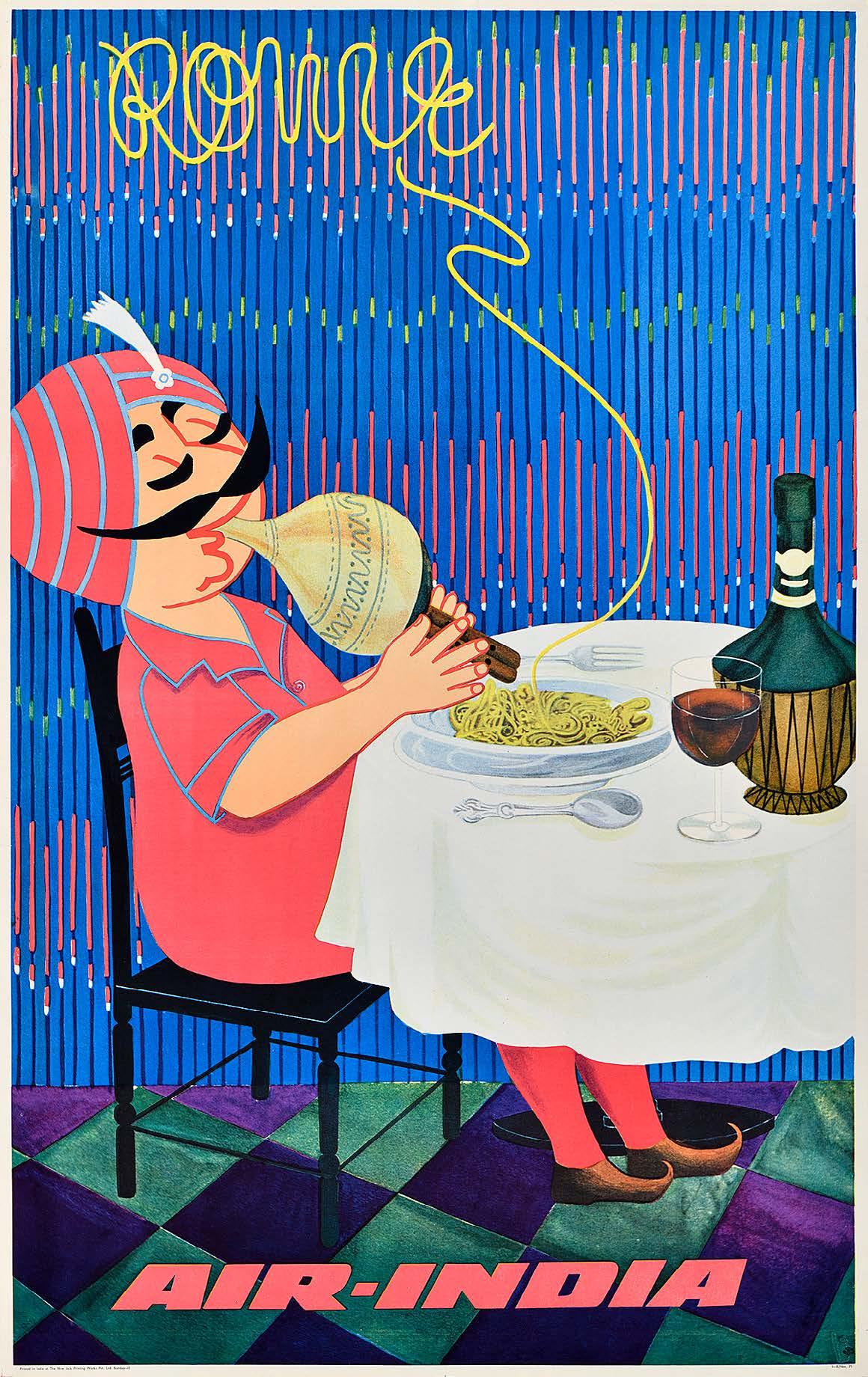
Poster House Permanent Collection
• This playful poster shows the Maharaja playing a pungi, an Indian wind instrument traditionally used by snake charmers in street performances. Evidently, the Maharaja could not find any serpents to enchant in Rome, so he made do with the closest thing he could find—spaghetti. With his sweet melodies, he humorously charms his dinner into forming the word “Rome” in letters above his head.
• In such posters, Air-India hoped to present an exoticised version of India—a land of rajas (princes), snake charmers, and fakirs (Hindu ascetics). While this tactic was good for business, it was often criticized for encouraging false and outmoded ideas about the country.
• Like the European skiing poster, this one exemplifies Air-India’s assertion of the Maharaja’s distinctly Indian identity, regardless of his destination.

• To many of his loyal followers, the Maharaja was almost a real person. Large figurines such as these were displayed at Air-India booking offices, airport counters, and travel agencies. Smaller versions were often given away as souvenirs to passengers, staff, and business associates, allowing Air-India to forge even closer connections with fans around the world.
• A 1995 news article in Metropolis describes a letter written to Bobby Kooka by the parent of one of the Maharaja’s devotees: “The girl was twelve years old and was battling with cancer. Her father wrote to Kooka after her death that the little girl was so fond of the Maharaja that, when in pain, she would often request to be driven down to the Air-India building where she could view ‘Kullu,’ a sobriquet given to the Maharaja by her. And this would give her a strange sense of satisfaction. But soon after, things took a serious turn, and she was taken to Calcutta for further treatment. In their new locale, however, her parents were unable to show her the Maharaja and therefore decided to give her a smaller version. And it was this idol of the Maharaja that she clutched on to, moments before her death, writes the father.”

• Air-India released numerous Maharaja figurines. Here, he rides an elephant—a popular pastime for Indian rulers.
• The homes of many Indian families, even those who were not Air-India customers, featured one of these figurines. A 1996 newspaper article references this phenomenon: “Have you ever wondered how a mascot becomes more popular than the product itself? Such is the power of advertising that the moment you see the mascot you immediately identify it with the product. But some mascots overshadow the product. They become larger than life as it were, having an identity of their own. Take the Air-India Maharaja, for instance.”
With its creation of the Maharaja, Air-India introduced an entirely new genre of advertising that ultimately became essential to the mascot’s overwhelming success. The airline’s campaigns, characterized by satire, irreverence, and humor, consistently capitalized on their shock value. This was promoted by both the Maharaja’s many subversive and incorrigible guises as well as by the outrageous copy that often accompanied his image. While some were offended by this innovative and somewhat provocative strategy, the overwhelming popularity of the Maharaja suggests that most viewers were delighted by it. The airline’s concept of poking fun at its audience rather than paying deference to it was unprecedented, and changed the direction of advertising in India. More than 70 years later, the Maharaja’s influence can still be seen in other highly successful Indian marketing campaigns.
Most importantly, however, Air-India’s advertising style inserted the Maharaja into real-world dialogues, allowing him to interact with the public in a novel way. On his billboards, the Maharaja could be seen commenting not only on Air-India’s newest destinations, but also on Nixon’s politics and even the Queen of England’s pregnancy. As a result, he became a real person to many of his fans, one whose opinions on politics and current events were subject to just as much discussion as those of any public figure. The Maharaja’s unconventional position in society, however, was not appreciated by certain politicians and world leaders, who considered some of his antics to be less than charming.
Despite much controversy, the Maharaja almost always got away with his transgressions, chiefly because of the distinctive personality devised for him by Air-India. His unintimidating, roly-poly figure, exaggerated cartoonishness, and overwhelming confidence served to moderate the worst of his provocations— and when the Maharaja’s excesses got him in trouble, Tata always came to the rescue: “he’s given us a great deal of rope, some of which we find around our neck, and then, bless his heart, he’s by our side, scissors in hand.”

• During the 1960s, Air-India began posting its billboards at the junction at Kemps Corner, a neighborhood in South Mumbai. As this form of advertising was fairly novel at the time, the location became an attraction in itself for visitors who wanted to keep up with the Maharaja’s latest antics.
• This magazine advertisement features a drawing of India House at Kemps Corner junction. The Maharaja, appearing on a billboard outside the building, speaks directly to two architects holding blueprints as they look back at him with curiosity. In a reference to then-current plans to add an overpass at the junction—a development Air-India feared would partially obscure the view of its landmark billboard location— the Maharaja makes sure to stake his claim on the prized advertising spot.

Courtesy of www.airindiacollector.com
• In another reference to current events, the figure of the Maharaja is seen in mirror image, each raising a sword over the head of Prince Philip as if ennobling him, next to a text reading “Jai Philip!”
• The prince made quite a splash when he visited Jaipur, India, in 1961, where he was photographed with the Queen and the Maharaja and Maharani of Jaipur behind a tiger he had killed while hunting—the same year he became the president of the British branch of the World Wildlife Fund.
• The meaning behind Air-India’s characteristically witty caption here can be seen from two angles, like the image of the Maharaja. While it could be interpreted as a pun on the word “Jai,” a traditional Hindi greeting meaning “victory” or “hail to,” it also refers to the name of the Maharaja of Jaipur at the time, Jai Singh.

Designer Unknown
Courtesy of www.airindiacollector.com
• When Britain withdrew from the Indian subcontinent in 1947, the area was divided into two independent countries: Pakistan (mostly Muslim) and India (technically secular but predominantly Hindu). Mass migration and violence followed across the region, and religious and territorial disputes escalated. In 1971, India and Pakistan entered into their third war. At the time, Nixon’s official policy regarding the conflict was one of “absolute neutrality”—one belied by the president’s obvious bias in favor of Pakistan and his persistent alienation of India. In Air-India’s well-timed billboard, the Maharaja is deployed to condemn “Dick” Nixon’s approach to the situation, which ignored the genocide of millions of Bengalis.
• Unlike most of Air-India’s billboards displayed within India, this design was first seen outside Air-India’s offices in New York— a direct statement, and provocation, to the Americans the airline saw as complicit in Nixon’s actions against the country.

Designer Unknown
Courtesy of www.airindiacollector.com
• In response to the Beatles’ recent visit to India, Air-India fashioned the Maharaja as the Maharishi Mahesh Yogi— the British band’s guru in Rishikesh.
• Mahesh Yogi became the mentor to many celebrities during the 1960s, including The Beach Boys, Donovan, and Mia Farrow. He taught his “Transcendental Meditation” technique in special “cram courses” for Westerners only. Unlike traditional ashrams that usually offer free lodging and demand their disciples’ lifelong devotion, the Maharishi’s course lasted just three months and cost $400 in 1968.
• In 1968, the New York Times commented that “the Maharishi isn’t the first swami to make it in the West, but he is probably the most flamboyant. Last weekend, he and the Beatles’ John Lennon went soaring over the ashrams at Rishikesh, a traditional pilgrimage center in the Himalayan foothills, in a helicopter. The holy men in the caves who dream of other forms of levitation could consider themselves outdone.”

Courtesy of www.airindiacollector.com
• For its 1966 Brussels poster, later made into a billboard, Air-India chose to illustrate the city’s famous Manneken Pis. This sculpture, made in 1618, shows a nude boy urinating into the basin of a fountain—an example of the city’s popular humor or zwanze . While this landmark was one of the main attractions in Brussels, Air-India’s choice of subject matter was criticized by the Belgian Ambassador to New Delhi, who suggested that his cultural attaché could easily supply images of more suitable landmarks.
• In a 1967 speech for the World Advertising Conference in London, Bobby Kooka said that: “I realise now that what we should have done was to make the Manneken stand below our Maharaja and have the little fellow hoisted with his own petard.”
















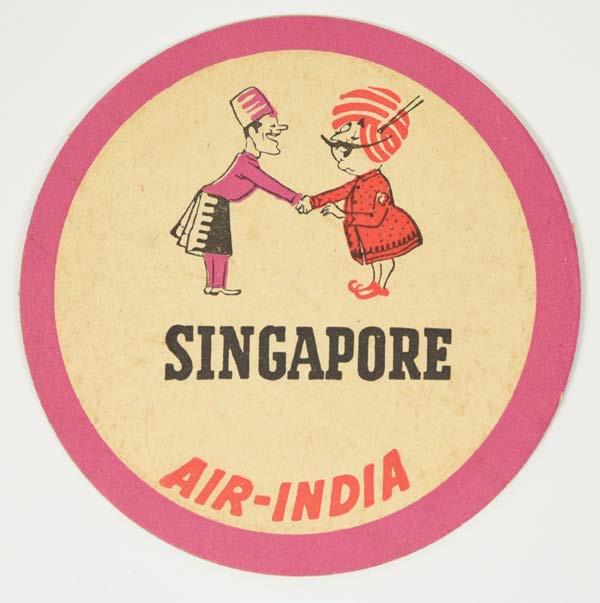

• Air-India produced a series of baggage labels and coasters from the 1950s through the ’60s, all featuring the same design of the Maharaja performing the traditional greeting of the relevant country with a local—bowing, shaking hands, kissing cheeks, or whatever it might be.
• In response to the airline’s Nairobi baggage label, an African dignitary wrote to the company asking if they “couldn’t conceive of a more fitting description of emerging Africa” (Kooka’s words). The same design also appeared on a small poster.

Designer Unknown
Poster House Permanent Collection
• In addition to advertisements for its airline, Air-India often collaborated with other agencies such as the Cigarette Manufacturers Association and the World Wildlife Fund. This is not surprising considering that the Indian government had held a majority share in Air-India since 1953. Thus, the Maharaja sometimes also took on the role of a Smoky Bear-like character, acting as a vehicle for government messaging.
• As a figurehead for the company—and, by proxy, for the Indian government—the Maharaja presented opinions on a range of subjects outside the airline industry, and frequently commented on current events and politics. These opinions were often made public on billboards.
• During the ’50s and ’60s, the company had a very different view about smoking, and handed out cigarette lighters and ashtrays to passengers as gifts. In one of Air-India’s most high-profile artistic collaborations, it commissioned Salvador Dalí to produce a decorative object in the form of an ashtray supported by swans that, when turned upside down, resembled elephants. In exchange for the project, Dalí requested (and received) a baby elephant. As the adverse health effects of smoking became more widely recognized, however, the company began to produce posters like this one, focused on public health.

Poster House Permanent Collection
• Throughout the 1960s, tiger hunts were a common theme in Air-India travel posters—whether the Maharaja was hunting tigers or tigers were hunting the Maharaja. This was related to a larger campaign by the Indian government, which hoped to ensnare tourists with a promise of big-game hunts. These adventures became as enticing to European travelers as India’s bazaars or the Taj Mahal, even attracting British royalty.
• In a 1960 article in the New York Times, Paul Grimes observed that “this is a fairly new development in the realm of diversions offered to tourists. Once the jungles were the playgrounds of maharajas. The princes are still there, but they are not as wealthy as they were before the Indian Government took over their states in 1948. They find it financially more prudent to set up tigers for tourists than to hunt the game themselves.”
• The copy for this poster reads “India for big game, Air-India for service,” making a statement on behalf of the country and the company—India is the best place for hunting, and Air-India is the best way to get there. This promotional strategy was short-lived: big-game hunting soon fell out of favor, and Air-India stopped using the sport to lure potential customers.

Poster House Permanent Collection
• While Air-India produced a variety of posters promoting the country as a hunting destination throughout the 1960s, when Bobby Kooka became associated with the World Wildlife Fund, its marketing followed suit and the Maharaja changed his view on the subject.
• Here, “Save Wild Life” is spelled out in capital letters composed of wild animals—the letter “D” is formed by a tiger with the smiling face of the Maharaja. This poster belongs to a series created by Air-India for the World Wildlife Fund, reflecting Kooka’s newfound activism.

Poster House Permanent Collection
• The Maharaja’s exploits often provoked public ire, especially when his caricatures of a particular country were not in keeping with its own self-image. In this poster, the Maharaja’s stint as a street performer outraged many who believed that the depiction of India as a “land of snake charmers’’ was both outdated and offensive.
• While it might be reasonable to assume that Air-India, essentially a government agency, would be motivated to present a more progressive vision of the country, such posters suggest that luring tourists and boosting sales were ultimately its top priorities—snake charming and princely palaces were clearly good for business.

Nargis Wadia (née Khambata) (b. 1935)
Poster House Permanent Collection
• This vibrant poster features lettering inspired by the legs of cabaret dancers at the Crazy Horse Saloon in Paris. The Maharaja, whose head dots the “I,” is shown ogling the dancers’ legs— a classic example of the mascot’s bawdy humor.
• In response to this poster, the head of the French Department at Osmania University in Hyderabad, India, wrote to the airline: “As a Frenchman, I was deeply shocked by this limited way of summing up my Capital…It would be better to avoid stressing the myth of France, the country of Love and of gay Paris. I would appreciate it if you could help destroy myths by deciding to discard this poster on Paris.”
• After the French government described the poster as an insult to the nation, the designers compromised and removed the Maharaja from the composition, replacing him with a simple dot above the “I.” While Cowasji and Kooka were fans of the original 1956 design, the “censored” version won the first prize at the Communication Arts Guild awards.

Nargis Wadia

K. K. Save (Dates Unknown)
Courtesy of www.airindiacollector.com
• In this calendar, the month of June is represented by a reproduction of the airline’s 1962 Paris poster. In it, the Maharaja appears in a trench coat and beret, lurking in a seedy alleyway where he opens his coat to reveal “naughty pictures” attached to the lining. Rather than illicit erotica, however, the images show the posturing and fully clothed form of the Maharaja himself, who is indeed quite naughty in his own way.
• Although this poster won first prize in the 1964 ASTA International Poster Contest in the United States, it was still subject to disapproval. The Minister of Cultural Affairs in Paris wrote to Air-India: “I was very badly surprised as a French citizen to see that an Air-India poster inviting Indians to visit Paris advertises for ‘nasty pictures’, which is not a sympathetic way to represent a country.”

We’ve made fun of ourselves, of our chairman, our directors, our countrymen, believing that by doing so, we could take a few liberties with those we love— our public.
—Bobby Kooka, Commercial Director, Air-India
• The Maharaja appears here dressed as a Playboy Bunny, serving drinks to a young Hugh Hefner (founder of Playboy magazine) and his then-assistant/cartoon editor/girlfriend, Cynthia Maddox. Although Maddox herself never made Playmate of the Month, she appeared on the cover of Playboy five times before breaking it off with Hefner after he refused to marry her.
• The sexual impropriety suggested by the Maharaja’s costume here perfectly encapsulates the bawdiness that was so fundamental to his personality. Often shown seducing women—laying his coat over puddles in a gentlemanly manner or inviting them to sit in his lap in a less-gentlemanly one— the Maharaja was undeniably, and quite humorously, a total stud.
• The Maharaja was ultimately able to behave in ways that no other national icon would even consider. His cartoonish absurdity, roly-poly figure, and unabashed personality made him simply too unintimidating for his actions to be taken very seriously, thus enabling him to push the boundaries of sexual conduct within advertising.

Unknown)
Illustrator: J. Walter Thompson Company, Bombay Private Collection, NYC
• While this humorous booklet was provided as on-board entertainment for every Air-India flight throughout the 1950s, ’60s, and ’70s, the airline was often criticized for its insulting illustrations of both Indians and Westerners. One chapter depicts several Westerners in comically large sun helmets in the style of stereotypical European explorers, with the accompanying text: “the pith helmet arouses little enthusiasm in this land. Its presence on your head will only mean that you’ll be taken for a ride when you go shopping…sunstroke is definitely cheaper.”

A Thousand Pardons , c. 1950
Courtesy of www.airindiacollector.com
• This “seat is occupied” card—made before airplane seats were preassigned—became the center of yet another controversy. It was removed from circulation soon after the Minister for Communications wrote to the head of Air-India, claiming that it went against the “traditions of Indian womanhood.”

• This booklet was distributed to new Air-India staff members, and outlined the company’s expectations of its employees. It also featured charming illustrations of the Maharaja going about his duties.

• The only known catalog of Air-India posters, The Rogue’s Gallery showcases 191 of the most important posters produced by the airline between 1946 and 1972. Along with an image of each poster, the catalog also includes the name of the illustrator and art director, as well as a list of any awards it received.

• In this magazine advertisement announcing Air-India’s inaugural service between New York and London, the company introduces the Maharaja with the phrase “Our Corporate Image.”

• The poster—replicated here as a postcard—ruffled the feathers of Leonard Lickorish, the general manager of the British Travel and Holidays Association. Unhappy with the depiction of the Maharaja reading a newspaper with the headline “London Smogbound,” he wrote to Air-India’s London office: “We do have an agreement with all the other National Tourist Boards, that international travel promotion should be positive, and should not include unfavorable references to any particular country. I would be grateful if you would consider this matter and particularly the suitability of distributing this poster outside Britain.”
As the Maharaja wreaked havoc across the globe, the loyal team at Air-India’s in-house art studio was hard at work producing the poster and ephemera designs that won him international acclaim. Led by the progressive Jal B. Cowasji, the studio encouraged the talent of artists and designers from across the country. The airline also worked with the advertising firm of J. Walter Thompson Ltd. in Bombay (who helped design the Maharaja), and commissioned artists nationally and internationally to undertake special projects, including travel posters and its popular calendars. The daring artwork produced by both Air-India’s studio and its commissioned artists came to define the organization not only as a world-class airline, but also as a champion of Indian art.
Air-India’s artistic zeal extended beyond the formation of its famed studio. As noted by the airline’s own publicity material, the “empires of old” and “princes of yesteryear” were quickly fading away as patrons of the arts. Thus, Cowasji recognized a need for a new class of art collectors—institutions like Air-India that might play a role in upholding the artistic traditions of their country, preserving the past while creating innovative work that would show the world what India could contribute. Air-India therefore gradually built up a vast collection of classical and modern Indian art and became a dedicated patron of the work of contemporary Indian artists—much of which decorated the airline’s offices and studios.
As a custodian of the arts, Air-India used the Maharaja to advocate for the recognition of Indian art on an international level by situating him in art-historical contexts from which Indian art had been so often excluded. In this context, the Maharaja became not only an impersonator but also an appropriator of artistic styles. Whether illustrated by the curvilinear forms of Art Nouveau or the lyrical vibrance of Indian ragamala painting, the mascot made the genre his own. These somewhat irreverent tributes to celebrated works of art asserted that the Maharaja, and, by proxy, Indian art, could be confidently established within their ranks. As Jal B. Cowasji so aptly put it: “Through the years, the people have discovered that there are many works of art, but there is only one masterpiece: the Maharaja alias the Rogue.”
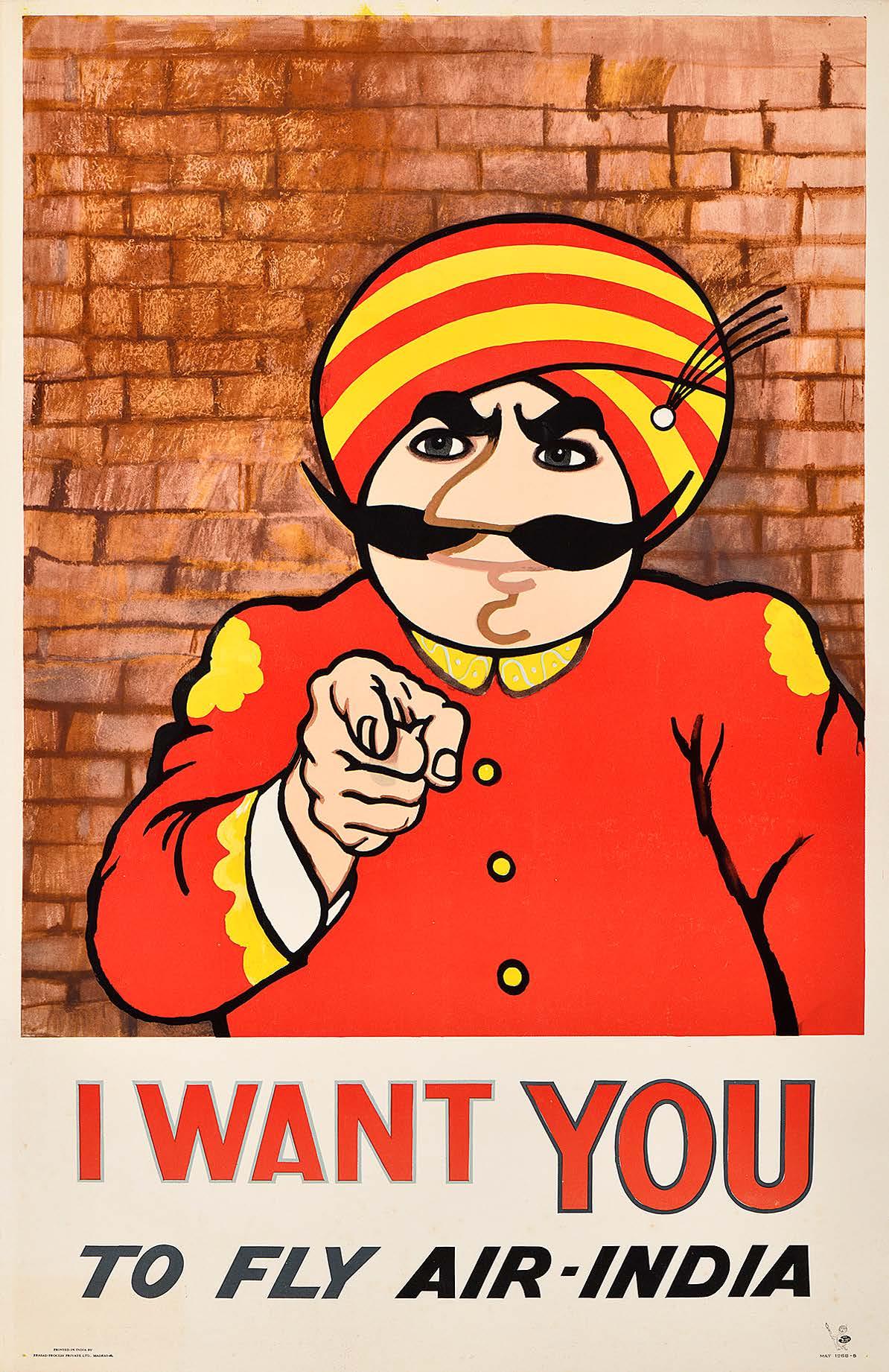
S. N. Surti (Dates Unknown)
Poster House Permanent Collection
• The artists of the Air-India studio drew their inspiration not only from classical Indian art but also from Western art traditions, which they often parodied, installing the Maharaja in a wide range of sometimes unlikely artistic contexts. Here, in a playful riff on the iconic World War I recruitment poster featuring Uncle Sam, the Maharaja makes a stern appeal to travelers, insisting that they fly Air-India.


K.K. Save (Dates Unknown)
Courtesy of www.airindiacollector.com
• This calendar image for the month of January is based on a 1962 poster in which Leonardo da Vinci’s Mona Lisa is shown painting a portrait of the Maharaja.
• In 1962, the original poster design won first prize at the ASTA International Poster Contest in the United States as well as first prize at the Government of India State Awards.

Poster House Permanent Collection
• This poster depicts London’s National Gallery—home to Francisco de Goya’s famous portrait of the Duke of Wellington that was stolen the year prior and not returned to the museum until 1965. Humorously, however, it is not this portrait that the art thief covets, but the portrait of Air-India’s very own Maharaja. In reference to this poster, Jal B. Cowasji jested that, “the Duke of Wellington was ready to ride to war again when he discovered that the Maharaja was preferred to him.”
• As with many of the Maharaja’s appearances, this composition relates to that of another poster produced the same year. Replicated in the calendar to the right, this image depicts the Mona Lisa painting a portrait of the Maharaja, making essentially the same joke. Rather than inserting the Maharaja into a known artwork, the Air-India studio presented the Maharaja as a masterpiece in and of himself—when confronted with these two famous artworks, the Maharaja emerges as the true treasure.

• Apart from the brilliant creativity of its own in-house design studio, Air-India also brought in outside artists to bring the Maharaja to life. Walter Langhammer was one of them. Born and raised in Austria, he fled to Bombay with his Jewish wife shortly before World War II. There, he became one of the founders of the Bombay Progressives, India’s most famous school of modern oil painting, eventually becoming the first art director of the Times of India .
• The Maharaja is shown here in the costume of a Kabuki actor in Tokyo. Kabuki is a traditional Japanese dance-drama characterized by ornate costumes and stylized performances.
• Although this poster was actually drawn by K. K. Save of the Air-India studio, Langhammer’s art direction can be clearly seen in the impressionistic brushstrokes and the pure, vibrant colors of which he was so fond.

The Air-India poster is a category in and of itself.
—Boundless: India, Sotheby’s Mumbai, Nov 29, 2018
David Gentleman (b. 1930)
Poster House Permanent Collection
• This poster is a woodcut illustration of the Maharaja as a beetroot—his roots, stretched out below him, form the “routes” of Air-India, labeled with the various destinations offered by the airline. This poster is one of a set featuring similar puns like “Take Route with Air-India” and “Exotic Froute of Air-India.” The latter received a Certificate of Merit at the Pacific Area Travel Association (PATA) Poster Contest in Manila in 1971.
• David Gentleman is an English artist best known for his woodcut illustrations and his murals in the Charing Cross Underground station in London. He also designed posters for London Transport, the Public Record Office, and the National Trust.
• Gentleman’s charming design showcases both the talent and versatility that Air-India sought from artists around the world. His work for the airline has a particularly British aesthetic and humor, and the artist’s clever puns meshed easily with the Maharaja’s wit, making the collaboration a most “frouteful” one.

David Gentleman (b. 1930)
Private Collection, NYC
• In addition to the “route” themed poster series, Air-India also commissioned David Gentleman to illustrate a book of puns titled Let’s Have an Affair-India , in which each Air-India-related pun was accompanied by a woodcut illustration featuring the Maharaja.

Designer Unknown
Poster House Permanent Collection
• This poster is inspired by the work of the English illustrator Aubrey Beardsley, a leading figure in the Aesthetic Movement, whose work influenced the development of Art Nouveau.
• The Maharaja is modeled after Beardsley’s 1897 cover design of Ali Baba for The Forty Thieves . Here, the Maharaja takes on Ali Baba’s dignified posture as well as the delicate positioning of his hands, his generous belly, loose black robe, and dangling bracelets.
• Behind the Maharaja stands an Indian woman holding an elongated pitcher with which she refills his drink, the billowing curve of her dress recalling that in another Beardsley illustration, The Peacock Skirt (1893), which accompanied Oscar Wilde’s one-act play, Salome.
• It is significant that of all Beardsley’s illustrations, Air-India chose to recreate those that had themselves been inspired by Asian art—the image of a turbaned Eastern potentate and the other featuring peacock feathers are both associated with the “exotic” East. By recreating these images, Air-India reclaimed them as its own.

Cover Design for The Forty Thieves, 1897 Aubrey Beardsley

Designer Unknown
Private Collection, NYC
• The pattern on the women’s gowns comes from an in-house catalog meant to be used by Air-India artists in products such as posters and route maps. It also appears on the nearby Air-India poster showing the Maharaja as Beardsley’s Ali Baba, and was applied to saris worn by Air-India air hostesses.
• The original design was inspired by paintings produced in the Indian state of Malwa, with images of nayikas (heroines) surrounded by exotic flora and fauna.


Air-India/Paris , 1966
S. N. Surti (Dates Unknown)
Courtesy of www.airindiacollector.com
• In this poster, the Air-India studio again pays homage to a celebrated Western poster, in this case an 1892 lithograph by Henri de Toulouse-Lautrec titled L’Anglais au Moulin Rouge (The Englishman at the Moulin Rouge), a plagiary cheekily acknowledged by the words printed under the image: “with apologies to Lautrec.”
• Toulouse-Lautrec was a French post-Impressionist painter, illustrator, and printmaker best known for his posters of Parisian nightclubs like the Moulin Rouge.
• This was accompanied by another design inspired by Toulouse-Lautrec’s 1893 lithographic poster showing Jane Avril doing her signature cancan kick. In it, the Maharaja appears beneath a double-bass that is gripped by an unseen musician.

Air-India/Paris, 1966
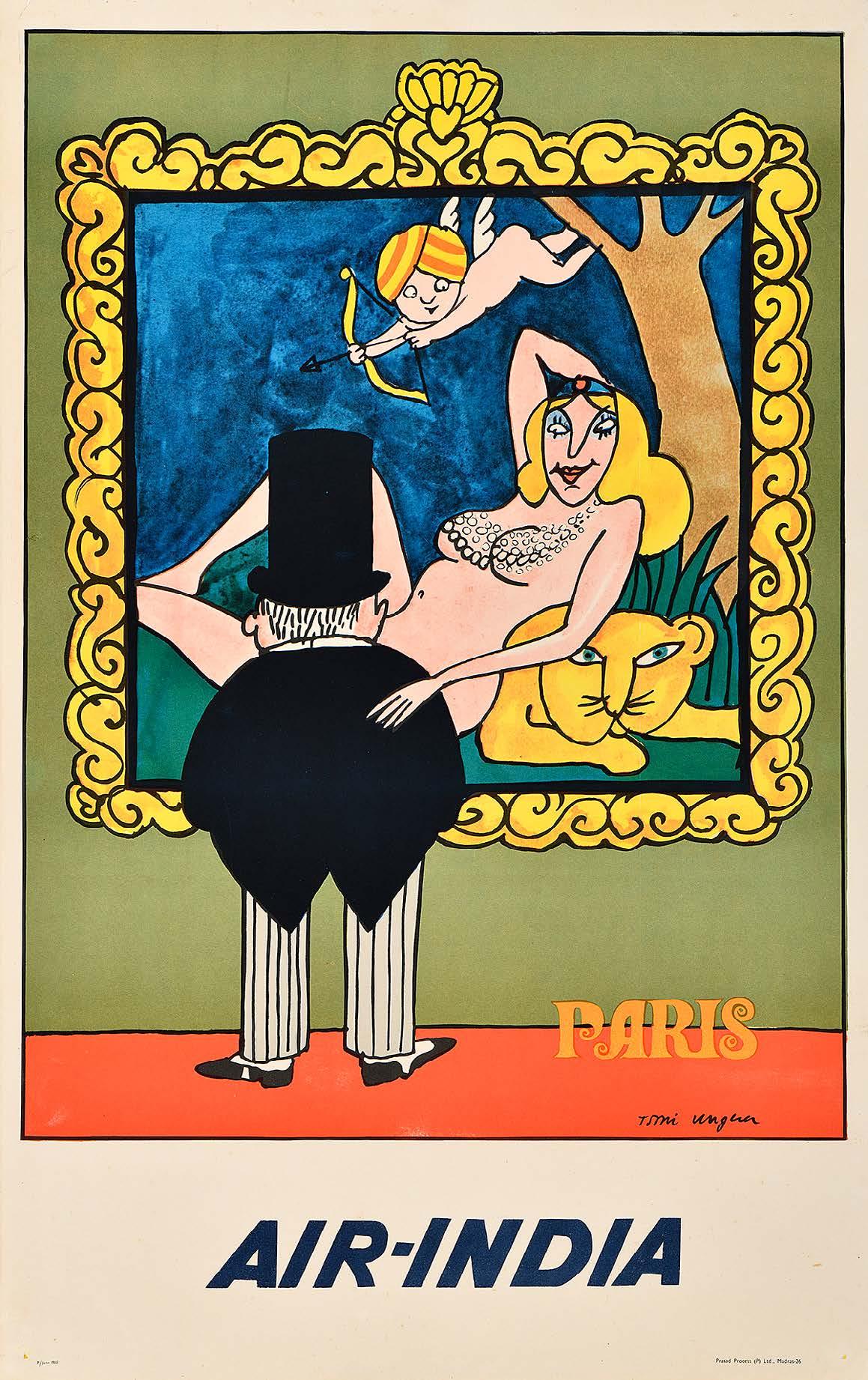
Courtesy of www.airindiacollector.com
• The collaboration between Tomi Ungerer and the Maharaja was a natural one. Although Ungerer was most famous for children’s book illustrations and political posters, he became notorious for his humorous and erotic imagery. Among them was a Kama Sutra -inspired book illustrated with frogs titled The Joy of Frogs (1982). The Maharaja’s cartoonish sexuality, paired with his wit and subversive behavior, made him the perfect subject for an illustrator whose own refusal to abide by the rules often got him in trouble. In fact, in the early 1970s, Ungerer’s children’s books were banned in the United States because of his more controversial work.
• This saucy image depicts a gentleman in a top hat at the Louvre “enjoying” a painting of a nude woman, whose hand reaches out of the painting to rest on his shoulder. The Maharaja, identified by his red-and-yellow turban, appears as a naughty putto, initiating the amorous scene with a shot of his love arrow.

• The image for this July spread is a slight variation on Ungerer’s Paris poster (to the left). In this version, a blushing gentleman stands with his back to the painting as he turns his head slightly to wink at the topless woman. His position is far less compromising than in the original illustration, allowing the calendar to be more appropriate for home display.
• The reference to J. Edgar Hoover in the poem in the lowerright corner alludes to the former F.B.I. director’s “crusade against smut” between the 1930s and the ’70s. Pornography, obscenity, and the politics of morality became significant subjects of the F.B.I.’s work during this period, resulting in the creation of official dossiers on figures as disparate as John Lennon and Georgia O’Keeffe. The agency also confiscated erotic photography and publications. Hoover’s campaign probably led to the blacklisting of Ungerer’s books.

The Gallery will never be complete.
The Maharaja will go on taking liberties, he will impersonate and be sentenced to a life-term—of love.
—Jal B. Cowasji, Publicity Manager, Air-India
Tomi Ungerer (1931–2019)
Poster House Permanent Collection
• While Air-India produced many high-quality posters, it was also famous for its calendars. In 1969, the controversial designer Tomi Ungerer made a series of posters for Air-India that were used to illustrate the airline’s 1971 calendar. Each of these images was accompanied by a witty poem, giving them the feel of a children’s book (a genre for which Ungerer was also known).
• The poem for this poster included the lines:
Haven’t you longed to see Italy?
Air-India whisks you to Rome.
At the Fountain of Trevi, there’s always a bevy Of coin-tossing tourists from Home.

Avinash Godbole (b. 1942)
Courtesy of www.airindiacollector.com
• This postcard replicates a poster from the airline’s ragamala series. The back of the postcard identifies the image as representing Raga Todi, a melody expressing the tender longing of separated lovers. It also specifies the time it should be played as when “the sun’s rays have lit the earth at dawn.”
• The Raga Todi is one of the more standardized ragamalas, almost always shown as a lone nayika (heroine) entrancing deer or gazelle with the song of the veena (an Indian stringed instrument), as seen in the watercolor painting below. Here, the Maharaja has become the nayika , serenely charming a nearby fawn.
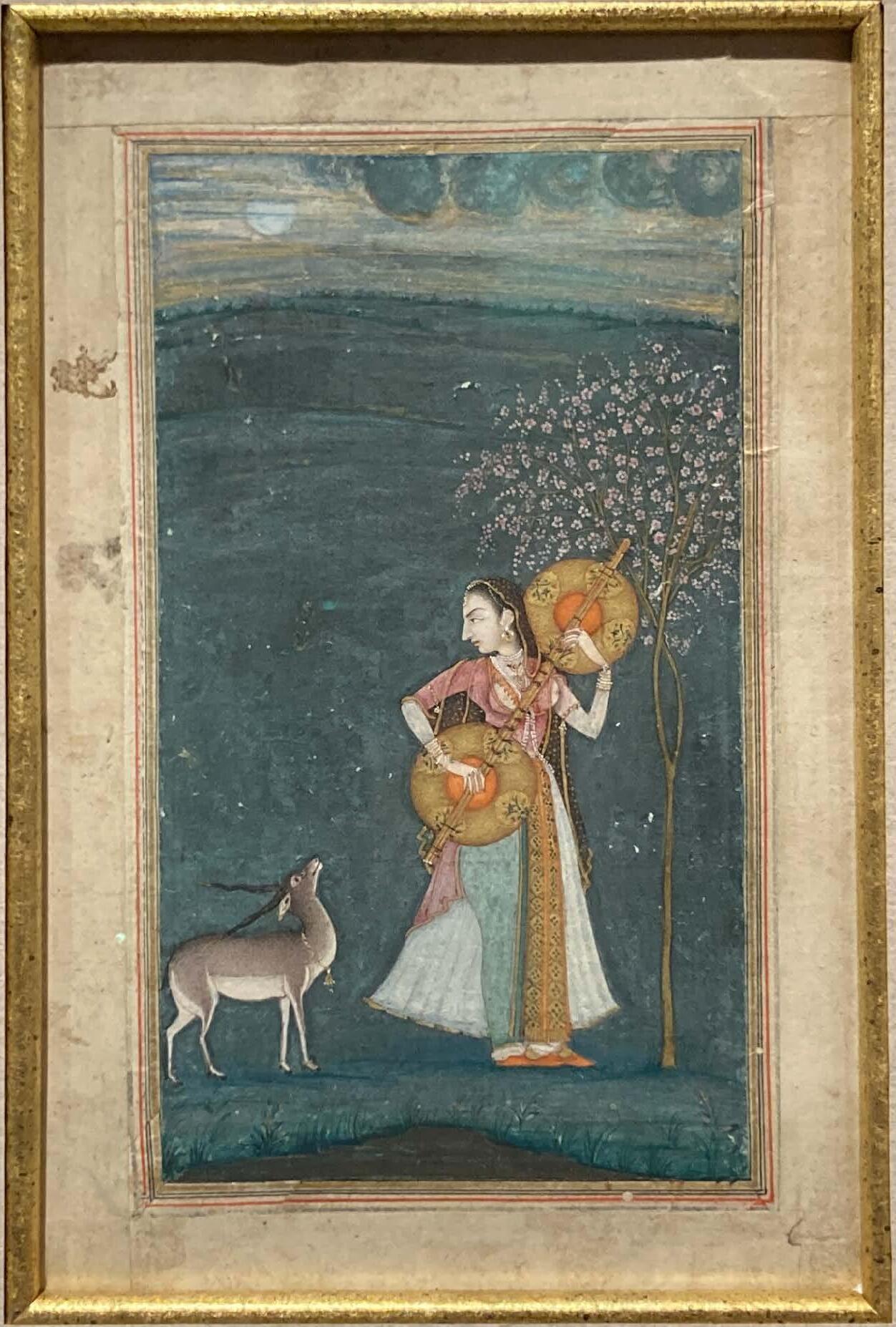
Opaque watercolor heightened with gold on paper
Courtesy of Kapoor Galleries, NYC
• This image depicts Todi Ragini, one of the many ragamalas that act as pictorial personifications of melodies within classical Indian music. Todi Ragini is often represented as a heroine playing a veena alongside a deer. As in the postcard of the Maharaja, the figure is seen alone, separated from her lover.

Raga Malkaus , c. 1975
Avinash Godbole (b. 1942)
Courtesy of www.airindiacollector.com
• Ragamala paintings serve to embody the musical moods or sentiments within the classification system of Indian music, categorized into 36 male and female personifications—ragas and raginis, respectively. Often focused around the concepts of “love in union” and “love in separation,” each painting is meant to evoke the feeling or color of the melody rather than a specific narrative.
• This poster comes from a set designed by Avinash Godbole for Air-India. The text at the lower margin of the poster includes the title of the specific raga or ragini depicted, as well as the mood it represents and the time it should be played. Rather than advertising a new travel destination, these posters are primarily educational, introducing this theme from classical Indian painting to the world. This approach was fully aligned with Air-India’s ambition to elevate the international status of Indian art.
• Raga Malkaus is a melody expressing intimacy and companionship in love, usually represented as a seated couple, sometimes holding veenas (Indian stringed instruments) or listening to music. Here, the designer took some creative liberties, combining the two lovers into a single form in the guise of the Maharaja.

Seated Nobleman on a Terrace , c. 1750
Attributed to Pandit Seu and his family workshop, Guler, India
Opaque watercolor heightened with gold on paper
Courtesy of Kapoor Galleries, NYC
• This portrait exemplifies a conventional form of Mughal portraiture during the classical period of Indian miniature painting. The nobleman is seated with his face in profile and body in three-quarter view as he smokes a hookah on an outdoor terrace.

• This advertisement is set up as a pseudo-classified ad, asking for information on a mysterious masterpiece (featuring the Maharaja styled in the manner of a classical Indian painting) that the airline supposedly has hidden away in its attic. This was not, of course, a real painting, but simply a design showing the Maharaja in one of his many guises.
• He is posed here as a prince holding a flower—a classical Mughal motif that symbolized the ruler’s cultural sophistication.

K. K. Save (Dates Unknown)
Poster House Permanent Collection
• Air-India paid homage to its cultural heritage with various poster themes and designs. This poster, for example, is modeled after classical hunting scenes produced by the Kotah school of painting, named after the northern Indian state in Rajasthan in which they were made.
• Shikar, or hunting for sport, was enjoyed by members of the Indian nobility beginning in the 18th century. Maharajas, venerated for their courage, pursued big game, including tigers, lions, boars, and elephants, and often used the activity to entertain such visiting dignitaries as British officers and Mughal princes.
• Hunting was particularly popular in the Bundi and Kotah regions of Rajasthan, where the Rajput rulers regularly commissioned local artists to illustrate it. This poster incorporates a number of characteristic features of these paintings—the Maharaja astride his decorated horse; the attendants following him with morchal (a fly whisk made of peacock feathers) and parasol in hand; the stylized foliage dotting the landscape; the figures’ faces in profile with bodies in three-quarter view; and the red border with lettering in a yellow box.

Bundi
Gouache heightened with gold on paper
Courtesy of Kapoor Galleries, NYC
• Depictions of the hunt, especially those involving tigers, were popular in the Bundi court as well as in neighboring Kotah and in their respective thikanas (fiefdoms). From the 17th through the 19th centuries, compositions showing dramatic altercations between animals like elephants and tigers were among the most imaginative and impressive in all Rajasthani painting.
• Kishen Singh, a prince from the Indian state of Bundi, is portrayed hunting big cats on horseback in a scene intended to emphasize his sporting prowess and his aristocratic lifestyle. The Maharaja’s appearance in a similar scene in the poster to the left similarly asserts his majesty and inserts him into the canon of classical Indian painting.

• This booklet was provided as in-flight entertainment for Air-India’s young travelers, and included puzzles and games that often featured the Maharaja.

• This pamphlet features recipe cards for the classic dishes of several Indian regions that were made available in flight. The inside flap also includes a tiny booklet listing select restaurants at Air-India destinations that serve the same meals.
• “Racy, spicey [sic], exotic delights” include Aloo Panir from Punjab, Macher Jhol from West Bengal, and Besan Kay Gatthay [Besan Ke Gatte] from Rajasthan.

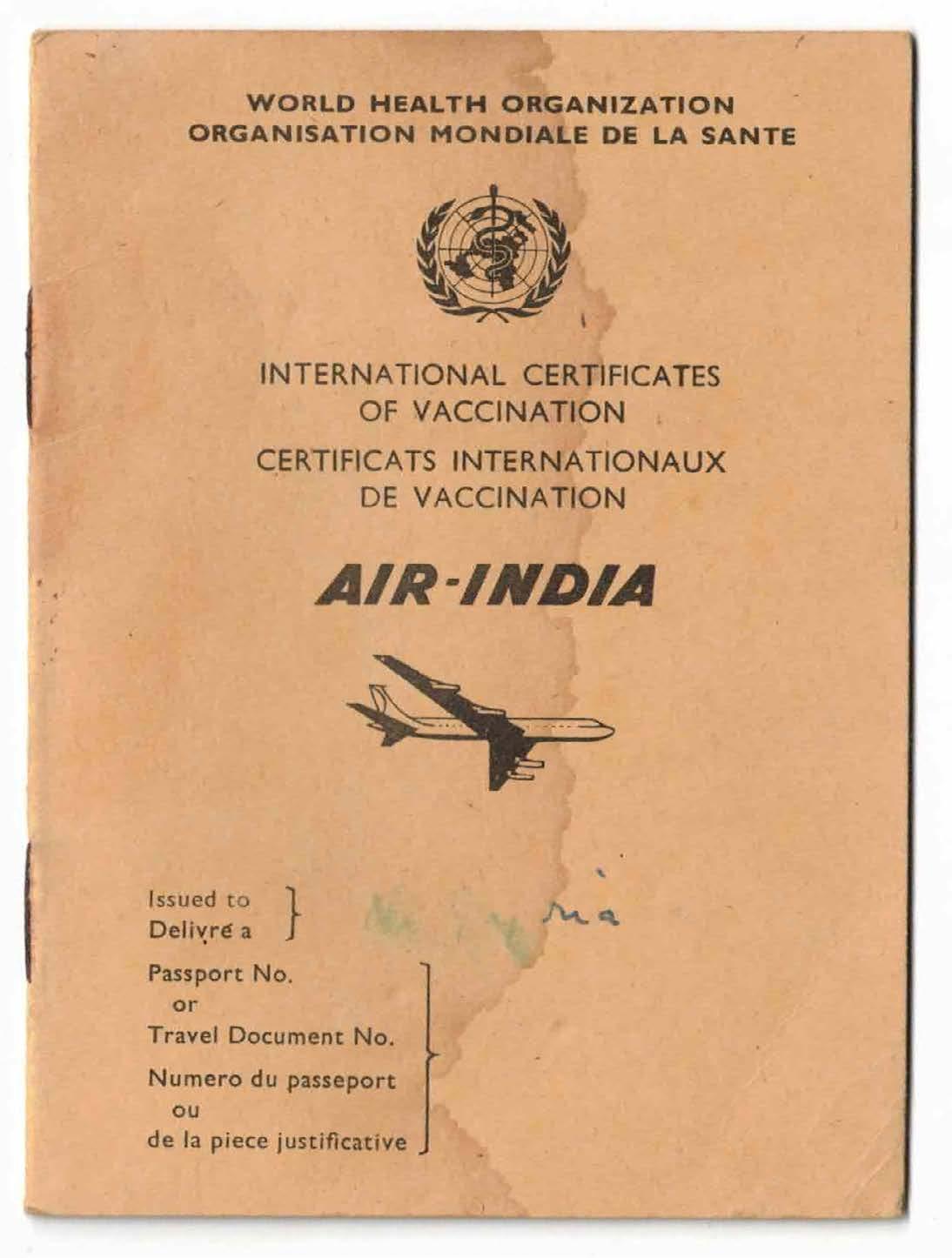
• This booklet of vaccination certificates issued by the World Health Organization takes on more immediacy in light of the current public-health crisis. Air-India required passengers to receive smallpox, yellow fever, and cholera vaccinations before traveling to and from certain regions.
• The cover of the booklet shows the Maharaja flying in the Pushpaka Vimana, described in Hindu texts as alegendary flying chariot with the swan-like head of a hamsa bird.

Courtesy of www.airindiacollector.com
• In this image, the Maharaja proudly admires his art collection, declaring that “I appreciate art, I have to, for I love myself!” Such an assertion was undoubtedly warranted, as the Maharaja’s posters won countless awards throughout the mid-20th century, and the mascot’s originator, Bobby Kooka, received the top award of the Indian Society of Advertisers in 1960.







